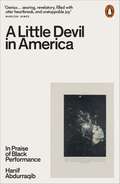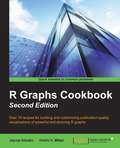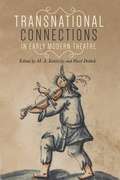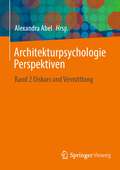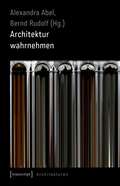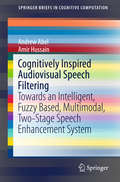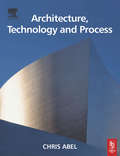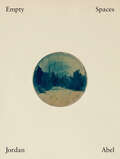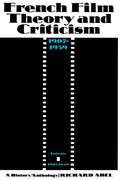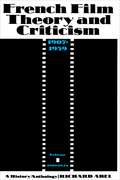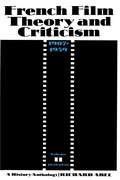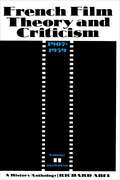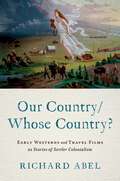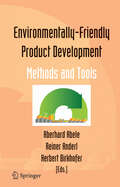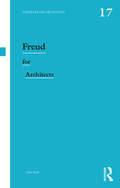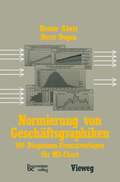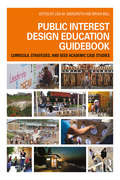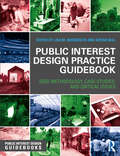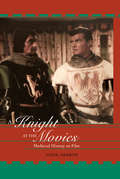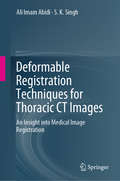- Table View
- List View
A Little Devil in America: In Praise of Black Performance
by Hanif AbdurraqibAn electrifying celebration of Black performances, cultures and communities in the United States, from the New York Times bestselling poet and critic Hanif Abdurraqib'Gorgeous' - Brit Bennett'Pure genius' - Jacqueline Woodson'One of the most dynamic books I have ever read' - Clint SmithAt the March on Washington, Josephine Baker reflected on her life and her legacy. She had spent decades as one of the most successful entertainers in the world, but, she told the crowd, "I was a devil in other countries, and I was a little devil in America, too". Inspired by these words, Hanif Abdurraqib has written a stirring meditation on Black performance in the modern age, in which culture, history and his own lived experience collide.With sharp insight, humour and heart, Abdurraqib explores a sequence of iconic and intimate performances that take him from mid-century Paris to the moon -- and back down again, to a cramped living room in Columbus, Ohio. Each one, he shows, has layers of resonance across Black and white cultures, the politics of American empire, and his own personal history of love and grief -- whether it's the twenty-seven seconds of 'Gimme Shelter' in which Merry Clayton sings, or the magnificent hours of Aretha Franklin's homegoing; Beyoncé's Super Bowl show or a schoolyard fistfight; Dave Chapelle's skits or a game of spades among friends.
R Graphs Cookbook Second Edition
by Jaynal Abedin Hrishi V. MittalTargeted at those with an existing familiarity with R programming, this practical guide will appeal directly to programmers interested in learning effective data visualization techniques with R and a wide-range of its associated libraries.
Transnational connections in early modern theatre (Manchester University Press)
by Pavel Ábek M. A. KatritzkyThis volume explores the transnationality and interculturality of early modern performance in multiple languages, cultures, countries and genres. Its twelve essays compose a complex image of theatre connections as a socially, economically, politically and culturally rich tissue of networks and influences. With particular attention to itinerant performers, court festival, and the Black, Muslim and Jewish impact, they combine disciplines and methods to place Shakespeare and his contemporaries in the wider context of performance culture in English, Spanish, French, Dutch, German, Czech and Italian speaking Europe. The authors examine transnational connections by offering multidisciplinary perspectives on the theatrical significance of concrete historical facts: archaeological findings, archival records, visual artefacts, and textual evidence.
Architekturpsychologie Perspektiven: Band 2 Diskurs und Vermittlung
by Alexandra AbelIn der gebauten und vom Menschen beeinflussten Umwelt manifestiert sich unser Leben: Lebenshaltung, Lebensformen, Lebensentwurf. Indem man Architektur neu denkt, hat man daher das Potential, die derzeitige Form unseres Lebens zu überdenken. Ein solches Neu, Anders braucht eine Sensibilisierung für die Relevanz der gebauten Umwelt, für die Werte und Zielgrößen, die hinter einer bestimmten Gestaltung stehen und braucht einen gesamtgesellschaftlichen Diskurs zu der zentralen Frage: Wie wollen wir leben? Wie dürfen wir leben? Vor dem Hintergrund ökologischer und ökonomischer Fairness: Welche Lebensformen sind kompatibel mit einer möglichst hohen Lebensqualität für uns alle, als Teil eines Ökosystems, mit dem unser Wohlbefinden unauflöslich verbunden ist. In diesem Band kommen namhafte Expertinnen aus Österreich, der Schweiz und Deutschland aus den Disziplinen der Architektur, der Psychologie, der Kunst und Kunstdidaktik zu Wort, die sich zu der Relevanz und zu den Voraussetzungen einer solchen Debatte äußern.
Architektur wahrnehmen (Architekturen #53)
by Alexandra Abel Bernd RudolfArchitektur beeinflusst uns wie kaum ein anderer Umweltfaktor. Eine intensive Beschäftigung mit ihr ist deshalb in unserem ureigensten Interesse. Architekten, Psychologen, Bildhauer, Kunstdidaktiker, Geschichts- und Medienwissenschaftler, Kunstgeschichts- und Erziehungswissenschaftler widmen sich in diesem Grundlagenwerk den unterschiedlichen Facetten der Architekturwahrnehmung und zeigen dadurch das Potential auf, das in einer Auseinandersetzung mit ihr liegt. So wird nachvollziehbar, was für Menschen geeignete Architektur ausmacht - über alle individuellen Präferenzen hinweg. Der nun in zweiter Auflage erscheinende Band richtet sich an Architektur-Studierende, Architekten, Umweltpsychologen und andere Beschäftigte im Bereich der Architektur sowie ganz ausdrücklich an alle Architektur-Nutzer. Mit Beiträgen von Alexandra Abel, Axel Buether, Andrea Dreyer, Yvonne Graefe, Roland Gruber, Jörg Kurt Grütter, Gemma Koppen, Rikola-Gunnar Lüttgenau, Luise Nerlich, Peter G. Richter, Bernd Rudolf, Caspar Schärer, Axel Seyler, Tanja C. Vollmer, Jessica Waldera und einem Vorwort von Ulf Jonak.
Cognitively Inspired Audiovisual Speech Filtering: Towards an Intelligent, Fuzzy Based, Multimodal, Two-Stage Speech Enhancement System (SpringerBriefs in Cognitive Computation #5)
by Andrew Abel Amir HussainThis book presents a summary of the cognitively inspired basis behind multimodal speech enhancement, covering the relationship between audio and visual modalities in speech, as well as recent research into audiovisual speech correlation. A number of audiovisual speech filtering approaches that make use of this relationship are also discussed. A novel multimodal speech enhancement system, making use of both visual and audio information to filter speech, is presented, and this book explores the extension of this system with the use of fuzzy logic to demonstrate an initial implementation of an autonomous, adaptive, and context aware multimodal system. This work also discusses the challenges presented with regard to testing such a system, the limitations with many current audiovisual speech corpora, and discusses a suitable approach towards development of a corpus designed to test this novel, cognitively inspired, speech filtering system.
Architecture, Technology and Process
by Chris AbelThis new selection of essays follows Chris Abel's previous best selling collection, Architecture and Identity. Drawing upon a wide range of knowledge and disciplines, the author argues that, underlying technological changes in the process of architectural production are fundamental changes in the way we think about machines and the world we live in.Key topics include: new patterns of urbanism in the fast growing cities of asia pacific; metaphorical extensions of mind and body in cyberspace; the divergent European and North American values shaping Sir Norman Foster's and Frank Gehry's work, and the collaborative work methods and technologies creating the adaptable design pratices of today.
Architecture, Technology and Process
by Chris AbelThis new selection of essays follows Chris Abel's previous best selling collection, Architecture and Identity. Drawing upon a wide range of knowledge and disciplines, the author argues that, underlying technological changes in the process of architectural production are fundamental changes in the way we think about machines and the world we live in.Key topics include: new patterns of urbanism in the fast growing cities of asia pacific; metaphorical extensions of mind and body in cyberspace; the divergent European and North American values shaping Sir Norman Foster's and Frank Gehry's work, and the collaborative work methods and technologies creating the adaptable design pratices of today.
Empty Spaces
by Jordan AbelA hypnotic and mystifying exploration of land and legacy, investigating what it means to be an intergenerational, Indigenous survivor of Residential Schools Jordan Abel’s new work grows out of the groundbreaking visual expression in his recently published NISHGA, a book that combined nonfiction with photography, concrete poetry, and literary inquiry. Whereas NISHGA integrated descriptions of the landscape from James Fenimore Cooper’s settler classic The Last of the Mohicans into visual pieces, Empty Spaces reinscribes those words on the page itself, and in doing so subjects them to bold rewritings. Reimagining the nineteenth-century text from the contemporary perspective of an urban Nisga’a person whose relationship to land and traditional knowledge and spiritual traditions was severed by colonial violence, Abel attempts to answer his research question of what it means to be Indigenous without access to familial territory. Engaging the land through fiction and metaphor, Abel creates an eerie, looping, and atmospheric rendering of place that evolves despite the violent and reckless histories of North America. The result is a bold and profound new vision of history that decenters human perception and forgoes Westernized ways of seeing. Rather than turning to characters and dialogue to explore truth, Abel invites us to instead understand that the land knows everything that can and will happen, even as the world lurches toward uncertainty.
French Film Theory and Criticism, Volume 1: 1907-1929
by Richard AbelThese two volumes examine a significant but previously neglected moment in French cultural history: the emergence of French film theory and criticism before the essays of André Bazin. Richard Abel has devised an organizational scheme of six nearly symmetrical periods that serve to "bite into" the discursive flow of early French writing on the cinema. Each of the periods is discussed in a separate and extensive historical introduction, with convincing explications of the various concepts current at the time. In each instance, Abel goes on to provide a complementary anthology of selected texts in translation. Amounting to a portable archive, these anthologies make available a rich selection of nearly one hundred and fifty important texts, most of them never before published in English.
French Film Theory and Criticism, Volume 1: A History/Anthology, 1907-1939. Volume 1: 1907-1929
by Richard AbelThese two volumes examine a significant but previously neglected moment in French cultural history: the emergence of French film theory and criticism before the essays of André Bazin. Richard Abel has devised an organizational scheme of six nearly symmetrical periods that serve to "bite into" the discursive flow of early French writing on the cinema. Each of the periods is discussed in a separate and extensive historical introduction, with convincing explications of the various concepts current at the time. In each instance, Abel goes on to provide a complementary anthology of selected texts in translation. Amounting to a portable archive, these anthologies make available a rich selection of nearly one hundred and fifty important texts, most of them never before published in English.
French Film Theory and Criticism, Volume 2: 1929-1939
by Richard AbelThese two volumes examine a significant but previously neglected moment in French cultural history: the emergence of French film theory and criticism before the essays of Andr Bazin. Richard Abel has devised an organizational scheme of six nearly symmetrical periods that serve to "bite into" the discursive flow of early French writing on the cinema. Each of the periods is discussed in a separate and extensive historical introduction, with convincing explications of the various concepts current at the time. In each instance, Abel goes on to provide a complementary anthology of selected texts in translation. Amounting to a portable archive, these anthologies make available a rich selection of nearly one hundred and fifty important texts, most of them never before published in English.
French Film Theory and Criticism, Volume 2: A History/Anthology, 1907-1939. Volume 2: 1929-1939
by Richard AbelThese two volumes examine a significant but previously neglected moment in French cultural history: the emergence of French film theory and criticism before the essays of Andr Bazin. Richard Abel has devised an organizational scheme of six nearly symmetrical periods that serve to "bite into" the discursive flow of early French writing on the cinema. Each of the periods is discussed in a separate and extensive historical introduction, with convincing explications of the various concepts current at the time. In each instance, Abel goes on to provide a complementary anthology of selected texts in translation. Amounting to a portable archive, these anthologies make available a rich selection of nearly one hundred and fifty important texts, most of them never before published in English.
Our Country/Whose Country?: Early Westerns and Travel Films as Stories of Settler Colonialism
by Richard AbelThe concept of settler colonialism offers an invaluable lens to reframe early westerns and travel pictures as re-enactments of the United States' repressed past. Westerns in particular propose a remarkable vision of white settlers' westward expansion that reveals a transformation in what "American Progress" came to mean. Initially, these films tracked settlers moving westward across the Appalachians, Great Plains, and Rockies. Their seizure of "empty land" provoked continual resistance from Indigenous peoples and Mexicans; "pioneers" suffered extreme hardships, but heroic male figures usually scattered or wiped out those "aliens." Some films indulged in nostalgic empathy for the Indian as a "Vanishing American." In the early 1910s, westerns became increasingly popular. In Indian pictures, Native Americans ranged from devious savages, victims of white violence, and "Noble Savages" to "in-between" figures caught between cultures and "mixed-descent peoples" partnered for security or advantage. Mexicans took positions across a similar spectrum. In cowboy and cowgirl films, "ordinary" whites became heroes and heroines fighting outlaws; and bandits like Broncho Billy underwent transformation into "good badmen." The mid to late 1910s saw a shift, as Indian pictures and cowgirl films faded and male figures, embodied by movie stars, dominated popular series. In different ways, William S. Hart and Harry Carey reinvented the "good badman" as a stoic, if troubled, figure of white masculinity. In cowboy films of comic romance, Tom Mix engaged in dangerous stunts and donned costumes that made him a fashionable icon. In parodies, Douglas Fairbanks subverted the myth of "American Progress," sporting a nonchalant grin of effortless self-confidence. Nearly all of their films assumed firmly settled white communities, rarely threatened by Indians or Mexicans. Masked as "Manifest Destiny," the expropriation of the West seemed settled once and for all. Our Country/Whose Country? offers a rich and expansive examination of the significance of early westerns and travel pictures in the ideological foundations of "our country."
Our Country/Whose Country?: Early Westerns and Travel Films as Stories of Settler Colonialism
by Richard AbelThe concept of settler colonialism offers an invaluable lens to reframe early westerns and travel pictures as re-enactments of the United States' repressed past. Westerns in particular propose a remarkable vision of white settlers' westward expansion that reveals a transformation in what "American Progress" came to mean. Initially, these films tracked settlers moving westward across the Appalachians, Great Plains, and Rockies. Their seizure of "empty land" provoked continual resistance from Indigenous peoples and Mexicans; "pioneers" suffered extreme hardships, but heroic male figures usually scattered or wiped out those "aliens." Some films indulged in nostalgic empathy for the Indian as a "Vanishing American." In the early 1910s, westerns became increasingly popular. In Indian pictures, Native Americans ranged from devious savages, victims of white violence, and "Noble Savages" to "in-between" figures caught between cultures and "mixed-descent peoples" partnered for security or advantage. Mexicans took positions across a similar spectrum. In cowboy and cowgirl films, "ordinary" whites became heroes and heroines fighting outlaws; and bandits like Broncho Billy underwent transformation into "good badmen." The mid to late 1910s saw a shift, as Indian pictures and cowgirl films faded and male figures, embodied by movie stars, dominated popular series. In different ways, William S. Hart and Harry Carey reinvented the "good badman" as a stoic, if troubled, figure of white masculinity. In cowboy films of comic romance, Tom Mix engaged in dangerous stunts and donned costumes that made him a fashionable icon. In parodies, Douglas Fairbanks subverted the myth of "American Progress," sporting a nonchalant grin of effortless self-confidence. Nearly all of their films assumed firmly settled white communities, rarely threatened by Indians or Mexicans. Masked as "Manifest Destiny," the expropriation of the West seemed settled once and for all. Our Country/Whose Country? offers a rich and expansive examination of the significance of early westerns and travel pictures in the ideological foundations of "our country."
Environmentally-Friendly Product Development: Methods and Tools
by Eberhard Abele Reiner Anderl Herbert BirkhoferDevelopment of environmentally friendly products gains an increasing - portance in science and in industry. While product development was strongly dedicated to achieve quality, cost and time targets, environmental issues indirectly had always been under consideration by engineers, see Fig. 1. Furthermore a methodology for the development of environm- tally sound products was missing. Despite of significant progress in using computer aided tools for product development and design, environmental aspects were attended. Computer aided tools typically do not include methods for considering environmental issues enabling the designer to - sess a product’s environmental effects. Fig. 1. Vision of Environment as a key target for product development v vi Preface Product related environmental issues are getting more and more political and public awareness. Development of environmentally friendly products has become an action item for both, politics and industry (UNFCCC 1997). Energy consumption is on the agenda and covers pollution and resource saving. Typical topics of directives of the European Union are waste, noise, air pollution, water, nature and biodiversity, soil protection, civil protection and climate change. After the translation into national law the development of environmentally friendly products is a basic approach to contribute to the fulfilment of the topics mentioned above. In the European Community a “Communication from the Commission to the Council and the European Parliament” on “Integrated Product Policy” was adopted on th 18 June 2003 (EC 2003).
Freud for Architects (Thinkers for Architects)
by John AbellFreud for Architects explains what Freud offers to the understanding of architectural creativity and architectural experience, with case examples from early modern architecture to the present. Freud’s observations on the human psyche and its influence on culture and social behavior have generated a great deal of discussion since the 19th century. Yet, what Freud’s key ideas offer to the understanding of architectural creativity and experience has received little direct attention. That is partly because Freud opened the door to a place where conventional research in architecture has little traction, the unconscious. Adding to the difficulties, Freud’s collection of work is vast and daunting. Freud for Architects navigates Freud’s key ideas and bridges a chasm between architecture and psychoanalytic theory. The book highlights Freud’s ideas on the foundational developments of childhood, developments on which the adult psyche is based. It explains why and how the developmental stages could influence adult architectural preferences and preoccupations, spatial intuition, and beliefs about what is proper and right for architectural design. As such, Freud for Architects will be of great interest to students, practitioners, and scholars in a range of disciplines including architecture, psychoanalysis, and philosophy.
Freud for Architects (Thinkers for Architects)
by John AbellFreud for Architects explains what Freud offers to the understanding of architectural creativity and architectural experience, with case examples from early modern architecture to the present. Freud’s observations on the human psyche and its influence on culture and social behavior have generated a great deal of discussion since the 19th century. Yet, what Freud’s key ideas offer to the understanding of architectural creativity and experience has received little direct attention. That is partly because Freud opened the door to a place where conventional research in architecture has little traction, the unconscious. Adding to the difficulties, Freud’s collection of work is vast and daunting. Freud for Architects navigates Freud’s key ideas and bridges a chasm between architecture and psychoanalytic theory. The book highlights Freud’s ideas on the foundational developments of childhood, developments on which the adult psyche is based. It explains why and how the developmental stages could influence adult architectural preferences and preoccupations, spatial intuition, and beliefs about what is proper and right for architectural design. As such, Freud for Architects will be of great interest to students, practitioners, and scholars in a range of disciplines including architecture, psychoanalysis, and philosophy.
Public Interest Design Education Guidebook: Curricula, Strategies, and SEED Academic Case Studies (Public Interest Design Guidebooks)
by Lisa M. Abendroth Bryan BellPublic Interest Design Education Guidebook: Curricula, Strategies, and SEED Academic Case Studies presents the pedagogical framework and collective curriculum necessary to teach public interest designers. The second book in Routledge’s Public Interest Design Guidebook series, the editors and contributors feature a range of learning competencies supported by distinct teaching strategies where educational and community-originated goals unite. Written in a guidebook format that includes projects from across design disciplines, this book describes the learning deemed most critical to pursuing an inclusive, informed design practice that meets the diverse needs of both students and community partners. Featured chapter themes include Fundamental Skills, Intercultural Competencies, Engaging the Field Experience, Inclusive Iteration, and Evaluating Student Learning. The book consists of practice-based and applied learning constructs that bridge community-based research with engaged learning and design practice. SEED (Social Economic Environmental Design) academic case studies introduce teaching strategies that reinforce project-specific learning objectives where solving social, economic, and environmental issues unites the efforts of communities, student designers, and educators. This comprehensive publication also contains indices devoted to learning objectives cross-referenced from within the book as well as considerations for educational program development in public interest design. Whether you are a student of design, an educator, or a designer, the breadth of projects and teaching strategies provided here will empower you to excel in your pursuit of public interest design.
Public Interest Design Education Guidebook: Curricula, Strategies, and SEED Academic Case Studies (Public Interest Design Guidebooks)
by Lisa M. Abendroth Bryan BellPublic Interest Design Education Guidebook: Curricula, Strategies, and SEED Academic Case Studies presents the pedagogical framework and collective curriculum necessary to teach public interest designers. The second book in Routledge’s Public Interest Design Guidebook series, the editors and contributors feature a range of learning competencies supported by distinct teaching strategies where educational and community-originated goals unite. Written in a guidebook format that includes projects from across design disciplines, this book describes the learning deemed most critical to pursuing an inclusive, informed design practice that meets the diverse needs of both students and community partners. Featured chapter themes include Fundamental Skills, Intercultural Competencies, Engaging the Field Experience, Inclusive Iteration, and Evaluating Student Learning. The book consists of practice-based and applied learning constructs that bridge community-based research with engaged learning and design practice. SEED (Social Economic Environmental Design) academic case studies introduce teaching strategies that reinforce project-specific learning objectives where solving social, economic, and environmental issues unites the efforts of communities, student designers, and educators. This comprehensive publication also contains indices devoted to learning objectives cross-referenced from within the book as well as considerations for educational program development in public interest design. Whether you are a student of design, an educator, or a designer, the breadth of projects and teaching strategies provided here will empower you to excel in your pursuit of public interest design.
Public Interest Design Practice Guidebook: SEED Methodology, Case Studies, and Critical Issues (Public Interest Design Guidebooks)
by Lisa M. Abendroth Bryan BellPublic Interest Design Practice Guidebook: Seed Methodology, Case Studies, and Critical Issues is the first book to demonstrate that public interest design has emerged as a distinct profession. It provides clear professional standards of practice following SEED (Social Economic Environmental Design) methodology, the first step-by-step process supporting public interest designers. The book features an Issues Index composed of ninety critical social, economic, and environmental issues, illustrated with thirty case study projects representing eighteen countries and four continents, all cross-referenced, to show you how every human issue is a design issue. Contributions from Thomas Fisher, Heather Fleming and David Kaisel, Michael Cohen, Michael P. Murphy Jr. and Alan Ricks, and over twenty others cover topics such as professional responsibility, public interest design business development, design evaluation, and capacity building through scaling, along with many more. Themes including public participation, issue-based design, and assessment are referenced throughout the book and provide benchmarks toward an informed practice. This comprehensive manual also contains a glossary, an appendix of engagement methods, a case study locator atlas, and a reading list. Whether you are working in the field of architecture, urban planning, industrial design, landscape architecture, or communication design, this book empowers you to create community-centered environments, products, and systems.
A Knight at the Movies: Medieval History on Film
by John AberthImagining the Middle Ages is an unprecedented examination of the historical content of films depicting the medieval period from the 11th to the 15th centuries. Historians increasingly feel the need to weigh in on popular depictions of the past, since so much of the public's knowledge of history comes from popular mediums. Aberth dissects how each film interpreted the period, offering estimations of the historical accuracy of the works and demonstrating how they project their own contemporary era's obsessions and fears onto the past.
A Knight at the Movies: Medieval History on Film
by John AberthImagining the Middle Ages is an unprecedented examination of the historical content of films depicting the medieval period from the 11th to the 15th centuries. Historians increasingly feel the need to weigh in on popular depictions of the past, since so much of the public's knowledge of history comes from popular mediums. Aberth dissects how each film interpreted the period, offering estimations of the historical accuracy of the works and demonstrating how they project their own contemporary era's obsessions and fears onto the past.
Deformable Registration Techniques for Thoracic CT Images: An Insight into Medical Image Registration
by Ali Imam Abidi S.K. SinghThis book focuses on novel approaches for thoracic computed tomography (CT) image registration and determination of respiratory motion models in a range of patient scenarios. It discusses the use of image registration processes to remove the inconsistencies between medical images acquired using different devices. In the context of comparative research and medical analysis, these methods are of immense value in image registration procedures, not just for thoracic CT images, but for all types of medical images in multiple modalities, and also in establishing a mean respiration motion model. Combined with advanced techniques, the methods proposed have the potential to advance the field of computer vision and help improve existing methods. The book is a valuable resource for those in the scientific community involved in modeling respiratory motion for a large number of people.
